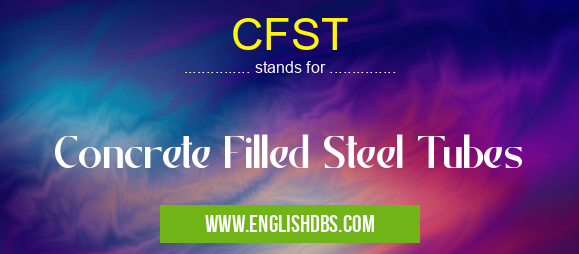What does CFST mean in UNCLASSIFIED
CFST stands for Concrete Filled Steel Tubes. They are composite structural elements consisting of a steel tube filled with concrete. CFSTs combine the strength and ductility of steel with the high compressive strength and fire resistance of concrete.

CFST meaning in Unclassified in Miscellaneous
CFST mostly used in an acronym Unclassified in Category Miscellaneous that means Concrete Filled Steel Tubes
Shorthand: CFST,
Full Form: Concrete Filled Steel Tubes
For more information of "Concrete Filled Steel Tubes", see the section below.
CFST Meaning in MISCELLANEOUS
CFSTs are commonly used in various miscellaneous applications, such as:
- Columns and beams in buildings and bridges
- Piles and foundations
- Offshore structures
- Energy absorption systems
CFST Full Form
The full form of CFST is Concrete Filled Steel Tubes.
What does CFST Stand for?
CFST stands for Concrete Filled Steel Tubes, which are composite structural elements consisting of a steel tube filled with concrete.
Essential Questions and Answers on Concrete Filled Steel Tubes in "MISCELLANEOUS»UNFILED"
What are Concrete Filled Steel Tubes (CFST)?
CFSTs are composite structural elements composed of a steel tube filled with concrete. The concrete core provides compression strength and ductility, while the steel tube enhances flexural and shear capacity.
What are the advantages of CFSTs?
CFSTs offer several advantages, including:
- Enhanced strength and ductility compared to traditional steel or concrete structures
- Excellent fire resistance due to the concrete core being protected by the steel tube
- Reduced construction time and costs due to prefabrication and rapid curing of concrete
- Improved seismic performance as the concrete core acts as a damper
- High energy absorption capacity
- Architectural versatility due to customizable tube shapes and concrete finishes
Where are CFSTs used?
CFSTs have a wide range of applications, such as:
- Buildings: columns, beams, trusses, and walls
- Bridges: piers, girders, and arches
- Offshore structures: piles, jacket legs, and caissons
- Industrial structures: silos, towers, and chimneys
- Military structures: bunkers, blast walls, and shelters
How are CFSTs designed?
CFSTs are typically designed using a combination of analytical methods and empirical data. Factors considered include material properties, cross-sectional geometry, and loading conditions. Design codes and guidelines provide specific requirements for CFST behavior and safety.
What are the challenges in using CFSTs?
Some challenges associated with CFSTs include:
- Complex material behavior due to the interaction between steel and concrete
- Potential for corrosion and bond failure if not properly protected
- Special construction techniques required for filling and consolidating concrete
- Limited flexibility and adaptability compared to some other structural systems
Final Words: CFSTs offer numerous advantages, including:
- Enhanced structural performance
- Improved fire resistance
- Reduced construction costs
- Aesthetic appeal
CFSTs are versatile and adaptable elements that have gained widespread use in various engineering applications. Their combination of strength, durability, and cost-effectiveness makes them a valuable choice for structural design.
